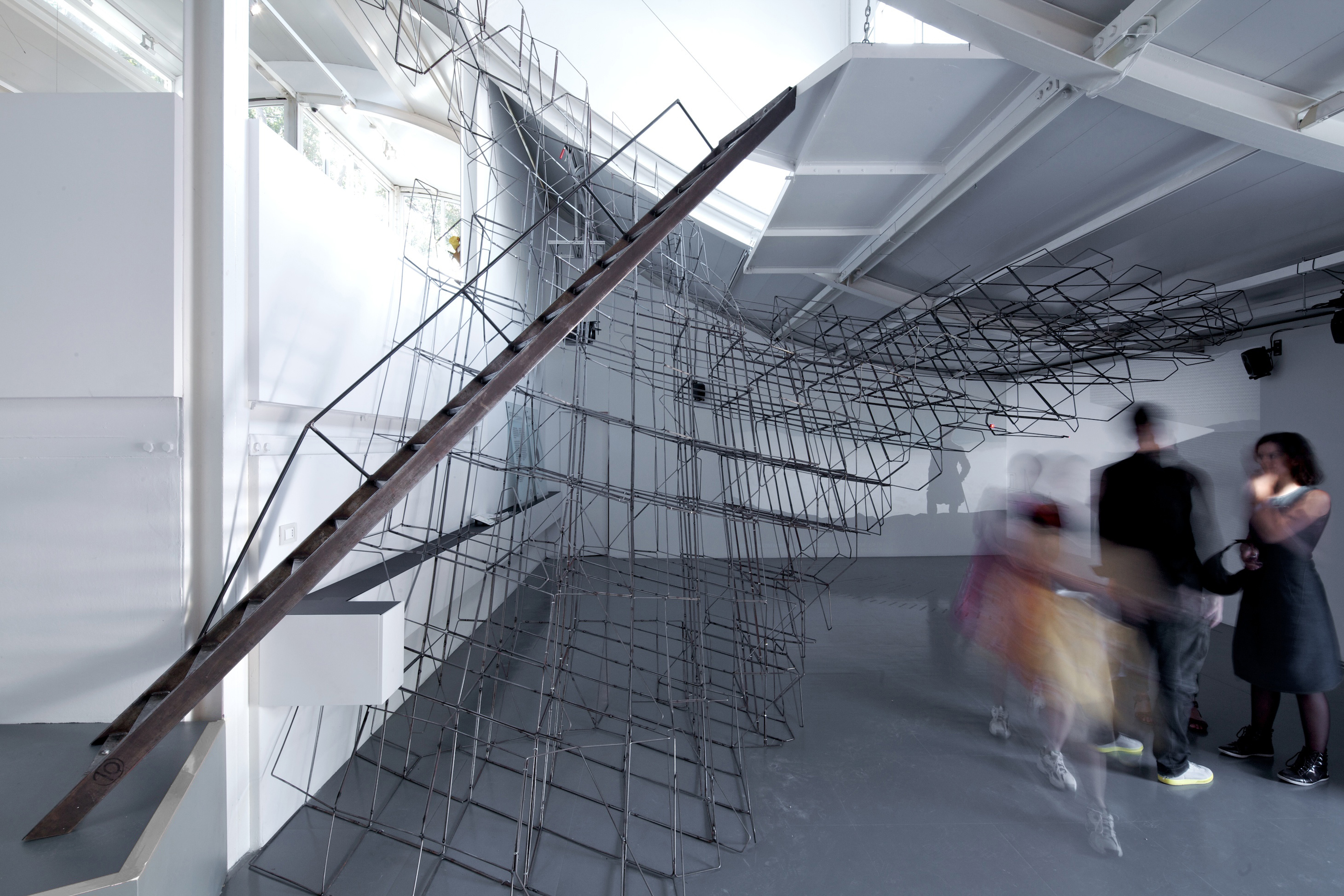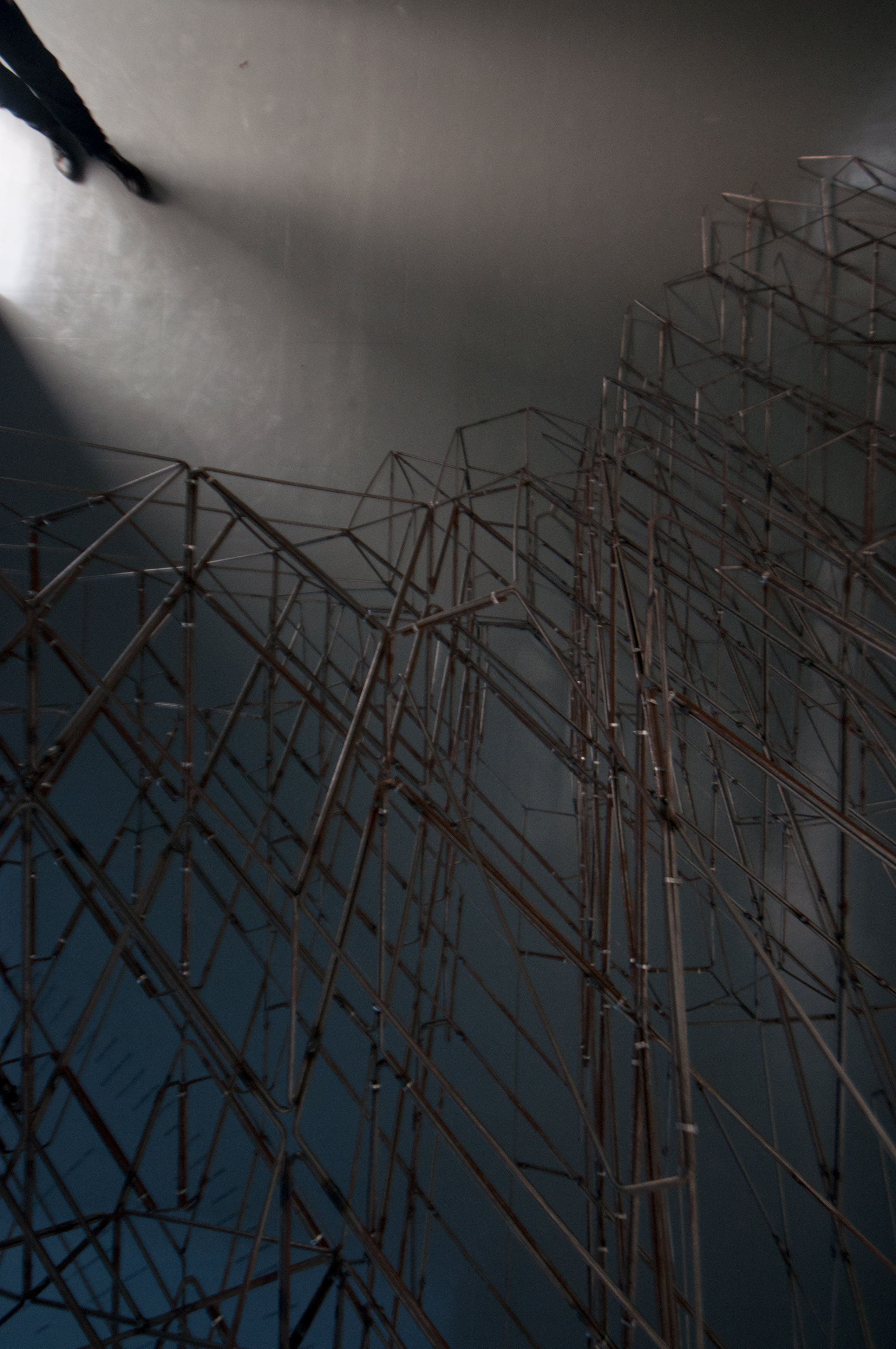cV Clouds of Venice
| PROJECT DATA |
|---|
| TYPE | INSTALLATION ROBOTIC FABRICATION |
|---|---|
| LOCATION | VENICE ITALY |
| CLIENT | AUSTRALIAN INSTITUTE OF ARCHITECTS |
| DATE | 2012 |
| TEAM | IAIN MAXWELL DAVE PIGRAM WES McGEE LAUREN VASEY BEN HAGENDORFER NIELS KRISTENSEN CHRIS DUFFIELD |
| IMAGES | NICO SAIEH CATIE NEWELL NIELS KRISTENSEN TOM LEA |
| EXHIBITIONS | 2012 VENICE BIENNALE |
| PUBLICATIONS | FORMATIONS: NEW PRACTICES IN AUSTRALIAN ARCHITECTURE |

Clouds of Venice
Venice, Italy
cV
An ultra high population of customised robotically bent steel rod elements creates a diffuse visual and spatial gradient.
Architectural space is traditionally composed through a small number of elements such as walls, ceilings and columns. The Clouds of Venice , our installation for the 2012 Venice Biennale of Architecture, proposed an alternate definition: diffused space. Through the assembly of an ultra high population of customised robotically fabricated bent steel rod elements, we sought the creation of a spatial and visual gradient which depending upon the observer’s position varied from transparent to opaque.
The Clouds of Venice is a site specific installation produced for the 2012 Venice Architecture Biennale. Designed by SM in collaboration with Matter Design Studio, the structure was commissioned by the Australian Institute of Architects.
No construction drawings of the project exist! Instead some 5,000 lines of generative code and almost 50,000 lines of file-to-factory robot control code allowed 6,800 unique bends to be applied to over 5,200 linear metres of 1⁄4” diameter mild steel rod. Mass-customisation was handled via the adoption and expansion of the marching cube (MC) algorithm. Traditionally used in computer graphics and medical imaging, the MC algorithm is used to extract a polygonal mesh from a discrete field of scalar values (voxel grid). Efficiently, the algorithm relies upon a finite set of topological states, albeit with near infinite variation, to resolve the mesh volume. Here, we couple a robotic fabrication (RF) technique to the MC algorithm via flirtatiously tracing the resulting polygon edges to realise an open-ended design method that approaches mass-customisation as the unique geometric distortion of a finite set of topologically consistent families of tectonic elements.
SM was selected as one of the six most innovative architecture practices to represent Australia in their pavilion. Curators Anthony Burke and Gerard Reinmuth had set the theme ‘Formations: New Practices in Australian Architecture’, exploring the many ways in which the profession of architecture is being transformed in order to face the challenges of contemporary practice. The commission was to “produce a new work that demonstrates the specific agency or potential of your unique practice structure”. ‘The Clouds of Venice’ demonstrates SM’s unique position at the overlap of practice, research and teaching; and the practice’s extreme level of technical and computational literacy. The realisation of the project was only made possible through the extensive international network of collaborators that is SM‘s practice formation.
The installation is an exemplar of a novel and highly collaborative trans-continental workflow where design files were generated in Sydney and London while the installation was robotically fabricated at the University of Michigan.
Robotic Fabrication
Clouds of Venice
Australian Pavilion
2012 Venice Biennale
Clouds of Venice
Australian Pavilion
2012 Venice Biennale
Formational Sequence
Left to right, top to bottom
00
The project’s form starts as grid
01
The grid is compressed to follow the iconic roof form of the existing Australian Pavilion designed by Phillip Cox.
02
One end of the grid is pinched. This creates the impression of false perspective. Approaching from the end side, the project appears longer. Returning from the narrow end the project appears shorter.
03
A second act of compression, this time on lower corners of the grid, creates a series of twisting ‘ruled-surfaces’. These are evident while circulating the installation.
04
A looped path is eroded leaving a larger overahanging element and a smaller island, These define the journey through the exhibition, screen. between various exhibitors and provide a place for display.
06
The resulting ‘cloud’.
Left to right, top to bottom
00
The project’s form starts as grid
01
The grid is compressed to follow the iconic roof form of the existing Australian Pavilion designed by Phillip Cox.
02
One end of the grid is pinched. This creates the impression of false perspective. Approaching from the end side, the project appears longer. Returning from the narrow end the project appears shorter.
03
A second act of compression, this time on lower corners of the grid, creates a series of twisting ‘ruled-surfaces’. These are evident while circulating the installation.
04
A looped path is eroded leaving a larger overahanging element and a smaller island, These define the journey through the exhibition, screen. between various exhibitors and provide a place for display.
06
The resulting ‘cloud’.

Fabrication
Each rod is precisely bent both in and out of plane via a robotically attended CNC bender which serves as an additional (external) axis.
Each rod is precisely bent both in and out of plane via a robotically attended CNC bender which serves as an additional (external) axis.

Marching CubesAn algorithm commonly used in medical imaging, marching cubes is here deployed to define a limited number of cell ‘families’. The diagram depicts the way that a single rod is folded in order to trace that cell.
Gaps in the tracing due to process constraints yield unequal numbers of rods at each joint. This is akin to the changing width of a calligraphic pen’s marks and contributes to the Clouds of Venice’s unique character.
Gaps in the tracing due to process constraints yield unequal numbers of rods at each joint. This is akin to the changing width of a calligraphic pen’s marks and contributes to the Clouds of Venice’s unique character.

Concept Render
The Clouds of Venice is designed to appear diffuse with changing degrees of opacity from every angle. Like fog at certain angles and proximities it is alomost transparent, at others almost entirely opaque.
The Clouds of Venice is designed to appear diffuse with changing degrees of opacity from every angle. Like fog at certain angles and proximities it is alomost transparent, at others almost entirely opaque.

Transparency
When viewed in parallel with the unpinched grid direction, the extremely thin 1/4 inch [6.35mm] diameter rods align and the assembly is almost transparent.
When viewed in parallel with the unpinched grid direction, the extremely thin 1/4 inch [6.35mm] diameter rods align and the assembly is almost transparent.

Formations Graphic
Designed by Toko.
Designed by Toko.



Tectonic Detail
Lines of varying thickness traverse the steel cloud.
Lines of varying thickness traverse the steel cloud.


